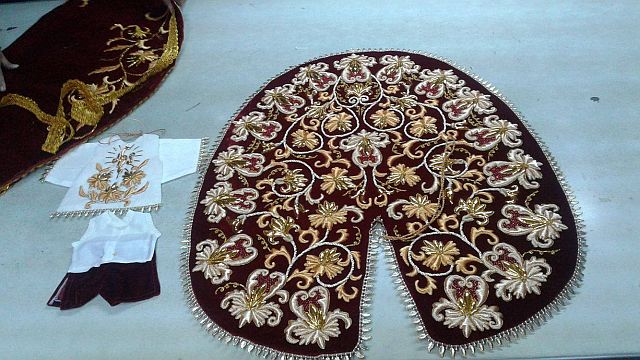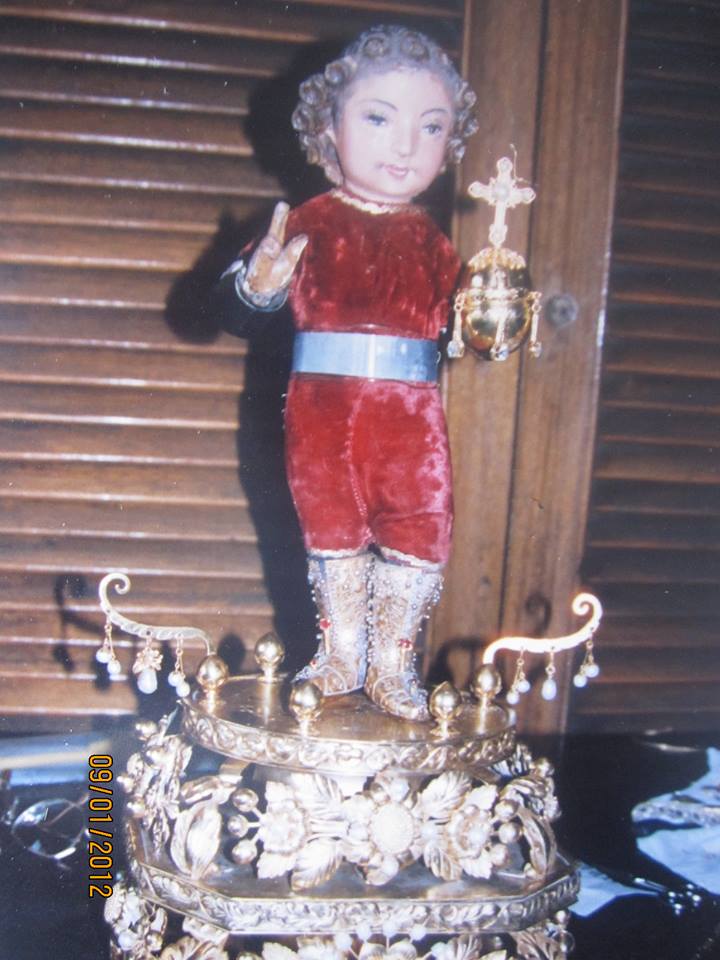Sinulog 2017: Clothing the Child King

The dress of Santo Niño de Cebu
For three decades, Sally Surabilla has one task she would not exchange for the world.
The head of the embroidery department of the Asilo de la Milagrosa in Cebu City and two female workers have been assigned to put together the entire ensemble of garments to be worn by the original image of the Sto. Niño de Cebu every year.
The task is far from routine, she said.
“We’re not just making an ordinary dress. We’re preparing something for the child Jesus—a king at that. It is but proper to give Him the best; a set of clothing that befits a king,” Surabilla told Cebu Daily News.
This year, the original image of the Sto. Niño will be clad in a maroon velvet cape intricately embroidered with gold and melon threads of lily corollas, coupled with off-white, heart-shaped leaves.
The details of Sto. Niño’s vestments were hand embroidered on both sides of the cape.
The white velvet alb with narrow sleeves closely resemble the designs on the cape except for the golden cross and the sacred inscriptions “IHS” which stands for the Latin phrase “Iesus Hominum Salvator” (Jesus the savior of all men).
It also represents the “Most Holy Name of Jesus” from which the title of the Archdiocese of Cebu as well as Cebu City’s original name was derived from.
The Sto. Niño is also fitted with undergarments: a kamiseta or undershirt of thin white cloth and pants.
‘Ilis’
The new vestments will be worn by the original image of the child Jesus today, said Fr. Ric Anthony Reyes, OSA, the media liaison officer of the basilica and the head of the Fiesta Señor’s general secretariat.
The usual venue for the ritual known as “ilis” is held either at the Grand Sala or the library inside the Basilica Minore del Sto. Niño.
Only the camareras or a selected group of women can change the clothes of the Holy Child.
In Spanish, a camarera means a chamberlain or lady-in-waiting and likewise refers to someone who acts as the caretaker of a monarch’s wardrobe.
Original Santo Niño

The Santo Niño de Cebu
The original image of the Sto. Niño that was given as baptismal gift by Portuguese explorer Ferdinand Magellan to Cebu’s Hara Humamay (Queen Juana) in 1521 is venerated in a glass case inside the side chapel of the Basilica Minore del Sto. Niño.
It is no longer brought out during the annual procession due to its fragility, said Fr. Reyes.
“The only time the original image is brought out of the glass case is when it gets a new set of vestments. Other than that, the sacred icon remains inside the chapel for public veneration,” he told
The Augustinian friars, who have custody of the image, use a replica during the traslacion, the solemn procession, and the traditional hubo or changing of the image’s clothes after the Fiesta Señor.
The original image of the Sto. Niño keeps the new vestments worn until next year.
The set of clothes removed from the original image is subsequently used by the replica kept at the rector’s office and used during the solemn foot procession.
Labor of love
It took about eight months to finish all the vestments for the original image of the Sto. Niño, said Surabilla.
“This year, the design was kind of a throwback. We decided to gather designs used in previous years, and mixed them all together to come up with what we have now,” she said.
Another worker at Asilo has been designing the vestments of the Sto. Niño for 13 years. She puts the design on a tracing paper attached to an abaca cloth, thin carton and velvet to make a pattern.
Her intricate designs are brought to life by another female worker who embroiders them by hand.
Surabilla said putting together the designs requires patience.
She said getting pricked by the needle is inevitable.
“What we are doing is really a labor of love. You have to love every part of it so that the result is beautiful,” the 58-year-old Surabilla said.
The seamstresses started preparing the vestments last May. It was completed last week and was immediately delivered to the basilica.
A woman has been the silent donor of the garments since 1985.
Special materials
She said she’s been asking the Asilo seamstresses to make the garments that she will present to the Augustinian friars to use for the original image of the child Jesus.
“She usually provides us with the (red) velvet fabric from the U.S. and then Asilo purchases other materials like the thread,” said Surabilla, who supervises the work and finishing.
The white velvet, she said, was bought in Japan, while the threads were imported from Spain and the U.S.
While preparing the vestments for the original Sto. Niño image, Surabilla said she prayed for her family’s well-being as well as peace for the country.
“I hope the killings will end,” she said, alluding to the number of drug-related deaths in the Philippines.
Happy and proud
Surabilla is overjoyed whenever she sees the vestments worn by the original Sto. Niño image.
“When I see the Sto. Niño wearing the vestments we made, I do not understand what I feel. I get goosebumps. I could not help but shed tears of joy,” she said.
“Last Sunday, while I was at the basilica, an elderly woman was looking at the Sto. Niño. She was amazed by its vestments. I tapped her shoulder and happily whispered to her ‘We made that,” she added with a big smile on her face.
Surabilla, a mother of four, credits the Sto. Niño for the blessings her family received as well as the “second life” of her eldest daughter.
In 2011, her daughter met a road accident on the way to joining the “Walk with Jesus” dawn procession that opens the novena Masses for the Sto. Niño feast.
“My daughter was on board a habal-habal motorcycle which got bumped by a car.
She got a blood clot in her head. She was vomiting. I never thought she would survive,” Surabilla said.
Miracle
After three days at the hospital, Surabilla said her daughter started to talk about a child with curly hair and an expensive toy.
“My daughter said the child wanted to play with her. I told her ‘there’s no child in the room.’ Then she said she could see several flowers and a lady.
And then she told me that she wanted to eat lamb. At that point, I became so nervous,” she said.
Surabilla said they took their family’s image of the Sto. Niño to the hospital after attending the solemn foot procession of the child Jesus held before the feast day.
“I was surprised. My daughter, who couldn’t get up for days, suddenly stood up. We were shocked. I believe it was the Sto. Niño who healed her. My daughter recovered,” she said.
Disclaimer: The comments uploaded on this site do not necessarily represent or reflect the views of management and owner of Cebudailynews. We reserve the right to exclude comments that we deem to be inconsistent with our editorial standards.
